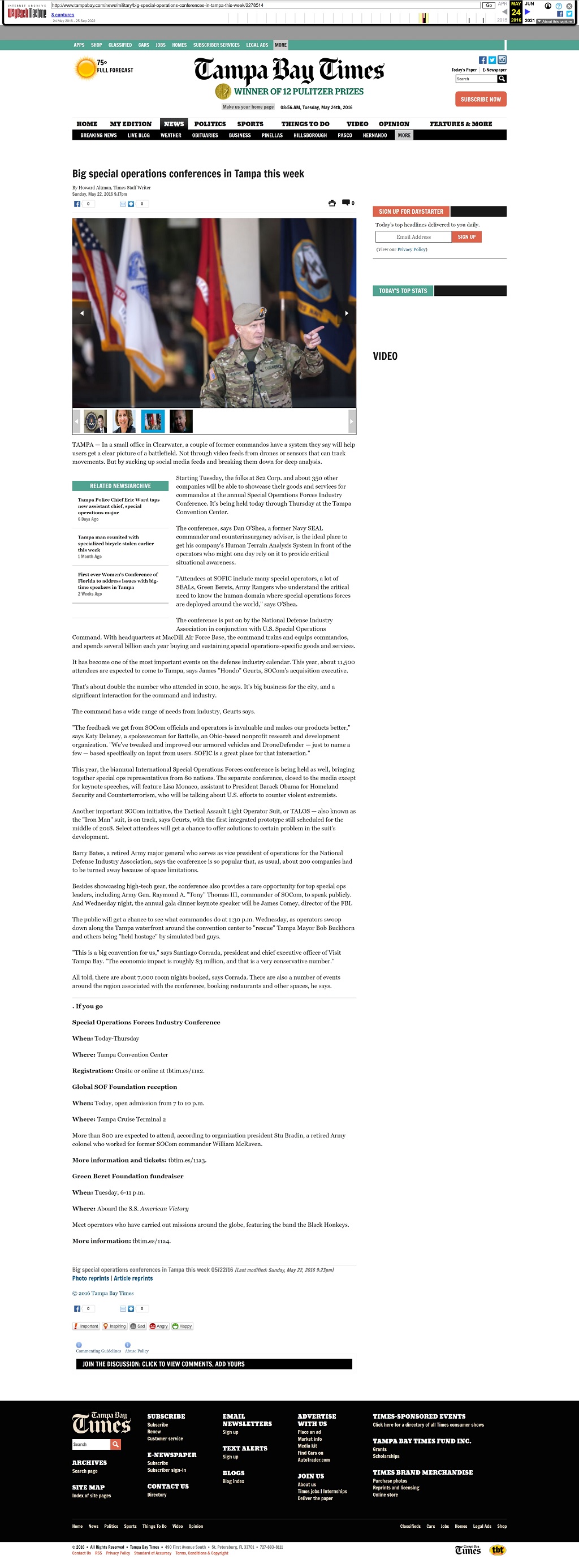
News / Military
By Howard Altman / Tampa Bay Times / May 22, 2016
PHOTO: Army Gen. Raymond A. “Tony” Thomas III, commander of U.S. Special Operations Command at MacDill Air Force Base in Tampa, will speak this week at the Special Operations Forces Industry Conference in Tampa. (MONICA HERNDON | Times)
TAMPA — In a small office in Clearwater, a couple of former commandos have a system they say will help users get a clear picture of a battlefield. Not through video feeds from drones or sensors that can track movements. But by sucking up social media feeds and breaking them down for deep analysis.
Starting Tuesday, the folks at Sc2 Corp. and about 350 other companies will be able to showcase their goods and services for commandos at the annual Special Operations Forces Industry Conference. It’s being held today through Thursday at the Tampa Convention Center.
The conference, says Dan O’Shea, a former Navy SEAL commander and counterinsurgency adviser, is the ideal place to get his company’s Human Terrain Analysis System in front of the operators who might one day rely on it to provide critical situational awareness.
“Attendees at SOFIC include many special operators, a lot of SEALs, Green Berets, Army Rangers who understand the critical need to know the human domain where special operations forces are deployed around the world,” says O’Shea.
The conference is put on by the National Defense Industry Association in conjunction with U.S. Special Operations Command. With headquarters at MacDill Air Force Base, the command trains and equips commandos, and spends several billion each year buying and sustaining special operations-specific goods and services.
It has become one of the most important events on the defense industry calendar. This year, about 11,500 attendees are expected to come to Tampa, says James “Hondo” Geurts, SOCom’s acquisition executive.
That’s about double the number who attended in 2010, he says. It’s big business for the city, and a significant interaction for the command and industry.
The command has a wide range of needs from industry, Geurts says.
“The feedback we get from SOCom officials and operators is invaluable and makes our products better,” says Katy Delaney, a spokeswoman for Battelle, an Ohio-based nonprofit research and development organization. “We’ve tweaked and improved our armored vehicles and DroneDefender — just to name a few — based specifically on input from users. SOFIC is a great place for that interaction.”
This year, the biannual International Special Operations Forces conference is being held as well, bringing together special ops representatives from 80 nations. The separate conference, closed to the media except for keynote speeches, will feature Lisa Monaco, assistant to President Barack Obama for Homeland Security and Counterterrorism, who will be talking about U.S. efforts to counter violent extremists.
Another important SOCom initiative, the Tactical Assault Light Operator Suit, or TALOS — also known as the “Iron Man” suit, is on track, says Geurts, with the first integrated prototype still scheduled for the middle of 2018. Select attendees will get a chance to offer solutions to certain problem in the suit’s development.
Barry Bates, a retired Army major general who serves as vice president of operations for the National Defense Industry Association, says the conference is so popular that, as usual, about 200 companies had to be turned away because of space limitations.
Besides showcasing high-tech gear, the conference also provides a rare opportunity for top special ops leaders, including Army Gen. Raymond A. “Tony” Thomas III, commander of SOCom, to speak publicly. And Wednesday night, the annual gala dinner keynote speaker will be James Comey, director of the FBI.
The public will get a chance to see what commandos do at 1:30 p.m. Wednesday, as operators swoop down along the Tampa waterfront around the convention center to “rescue” Tampa Mayor Bob Buckhorn and others being “held hostage” by simulated bad guys.
“This is a big convention for us,” says Santiago Corrada, president and chief executive officer of Visit Tampa Bay. “The economic impact is roughly $3 million, and that is a very conservative number.”
All told, there are about 7,000 room nights booked, says Corrada. There are also a number of events around the region associated with the conference, booking restaurants and other spaces, he says.
Wayback image

